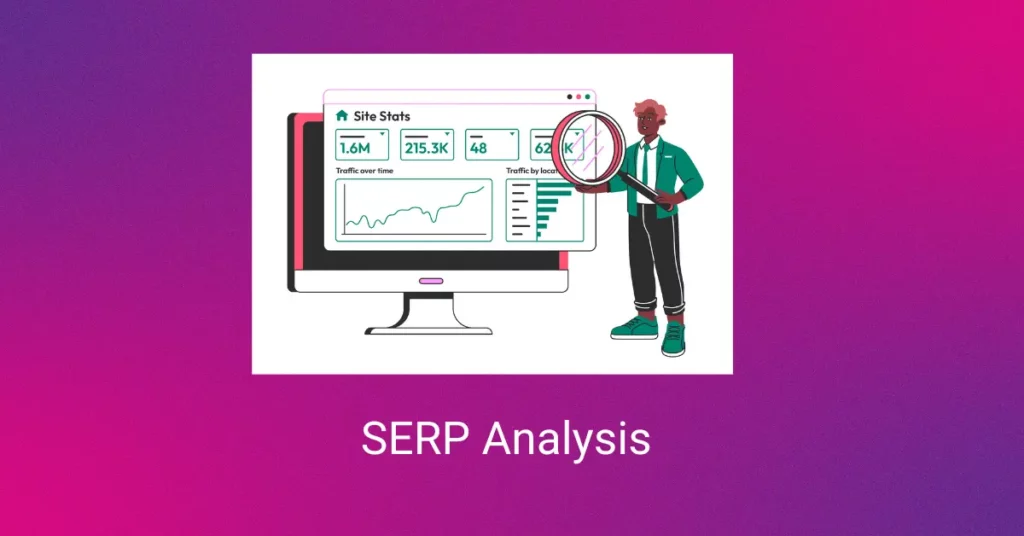
Witness an Increase in your ROI
Unlock higher rankings, quality traffic, and amplified conversions through tailored award-winning SEO strategies.
What is SERP analysis
After you type a query on a search engine, the results are displayed. This result page is known as Search Engine Results Page or SERP. Results consist of the top-ranking websites.
A SERP analysis is conducted to assess what these top-ranking websites are doing to achieve such good positions and what you need to do to outrank them.
The SERP analysis also evaluates whether or not a specific keyword is relevant to your industry and how difficult the competition is to rank for that keyword.
Importance of SERP Analysis
Find out keyword relevancy
SERP analysis allows for more insight into how relevant a keyword is for your business or industry. Marketers often select a keyword that seems super-relevant, and yet results don’t appear. It is because the keyword is either semantically incorrect or the search intent behind the query doesn’t complement the content you wish to provide.
Find out the ranking difficulty
How difficult it is to rank on top for a specific keyword varies from country to country. It depends on the top-ranking websites of each local SERP.
When you see a relevant top-ranking page, use a SERP analysis tool to evaluate the strength of the competitors based on multiple factors and metrics. These tools provide an accurate ranking difficulty store and comprehensive SEO stats for the top 10 search results. You can understand the complete picture using the following metrics to make informed decisions. If you are using, you can use the Google SERP analysis tool to understand the following:
- Domain Rating – The backlink profile of a website determines its strength. The link is more authoritative when the DR is higher.
- Domain Authority – To know how well a website will rank on search engines, you must understand domain authority (DA)
- URL Rating – highlights the strength of a specific URL’s backlink profile. This metric plays a prominent role in rankings.
- Backlinks Count – displays the number of inbound links pointing to a URL.
Discover ranking opportunities
Apart from keyword relevancy and ranking difficulty score, SERP analysis enables you to discover different ways of ranking on top of the search results faster. You can identify different opportunities to optimize your content, such as featured snippets and People Also Ask boxes, based on the particular SERP.
How to do SERP analysis?
Do keyword research
Before evaluating how your content ranks against competitors for search queries, perform keyword research and prepare a list of relevant keywords for your niche. Check where you currently rank for keywords on the list and note down the keywords you don’t rank for but want to target.
Keyword research can be done through different tools that are available online. Enter some seed keywords and find keywords related to your products and services.
You can also look at popular long-tail keywords that are relevant to your business. Watch out for keywords that reference your company name and location.
Identify search intent
After you prepare a list of keywords important for your business, analyze their SERPs and check their relevance to your business. Search intent helps in determining keyword relevance. The next step of SERP analysis will be identifying that intent.
Look at the keyword list you have and try to understand the main goal behind a user typing a query into a search engine. Some keywords will have topical relevance, but their relevance to the user’s intent is poor.
There are four types of search intent:
- Navigational intent – the user is searching for a specific brand or a website
- Transactional intent – the user is keen on purchasing a product or service
- Informational intent – the user wants to gather information and learn new things on a topic
- Commercial intent – the user wants to know more details about a product before buying.
SERP analysis helps you to decode the intent behind the keyword. This, in turn, can help in the optimization of your content to answer those user search queries.
Providing information that matches the user’s search intent helps to improve your SEO and conversion rates. Focusing on the type of content that is ranking on top should be prioritized before uncovering the search intent of a keyword.
Analyze your competitors
SERP analysis focuses a lot on comparing your rankings with your competitors’ rankings. In this step, you evaluate how difficult it would be to outrank the websites ranking on top in a particular SERP.
Competitive analysis is easy with online tools like SERPChecker. The tools provide the most extensive and accurate details about the ranking pages, including:
- Domain authority, Page authority (PA)
- Keyword difficulty metrics
- Backlinks count
- Citation flow, Trust flow
- URL rating
- Average CTR of competitors
Try to identify keywords with reasonable search volume and relatively low keyword difficulty to optimize your content for higher search ranking.
Check for ranking opportunities
One of the best aspects of SERP analysis is that it can help you identify hidden opportunities. These opportunities allow you to reach the top of the SERP and beat your competitors much faster.
Find ranking keywords that can go up on the SERP page. Also, find keywords that your competition isn’t targeting. If most of your authoritative competitors are trying to rank for specific short-tailed keywords, getting your page to display above them can be challenging. Shift your focus to long-tailed, more specific search terms that have a low competition score.
Optimize content
During competitive analysis, check what the top displaying content is addressing for a particular keyword. Are you providing similar information? If not, optimize your content to make it more complete and address topics naturally. When your content is relevant, it can help your website rise and serve as a better response to the user’s search intent.
You can leverage SERP analysis data to formulate your SEO strategy by including:
- Pay attention to SERPs that you can rank for
- Optimize content for SERP features like featured snippets, rich results, People Also Ask, etc.
- Write a better title tag and meta description
- Implement schema markup or structured data
- Identify competitor backlinks for replication
- Improve URL and other useful HTML tags
- Discover more content ideas based on the Related Searches and People Also Ask sections
Make sure you assess your website content consistently, adding new information and updating existing text and images based on SEO best practices. You must also add relevant keywords to the content if required. The data derived from SERP analysis tools help to get an overview of ranking difficulty and ideas on optimizing content better than the competition.
Keep track of SERP
The process of SERP analysis must be performed regularly. Track the SERPs you are ranking for and take action based on the changes seen in them. A change in SERP can happen at any time. The most common changes include the appearance or disappearance of SERP features, rise or drop in ranking positions, or alterations in the search intent.
Tools like SERPWatcher allow you to spot any significant changes occurring in SERP in the long run. You can track page performance for specific keywords. This also helps in evaluating their performance in the SERPs over time.
5 Best SERP Tools
Ahrefs Keyword Explorer
With the Keywords Explorer from Ahrefs, you can determine the difficulty level to rank in the top 10 search results for a chosen keyword. The keyword difficulty score, ranging on a scale of 1 to 100, with 100 being the highest, depends on a weighted average of the number of referring domains to the top 10 search results.
Moz Pro SERP Analysis Tool
Search Engine Results Page (SERP) analysis in Keyword Explorer by Moz Pro is one of the best SEO tools. It snapshots the first page of results and authority metrics for the keyword you feed in to calculate the keyword difficulty metric.
SE Ranking SERP Analysis Tool
This analysis tool helps you complete competitor research, develop a more robust SEO strategy, and enhance page performance. This is achieved by evaluating detailed SERP data for a keyword and the page quality score for every SERP competitor.
SERPChecker
Mangool’s SERPChecker lets you easily analyze SERPs for any city or country. You can view the strengths and weaknesses of your competition and use the data to improve rankings for your business. The SERP analysis tool lets you instantly identify the weak spots of your competitors.
SEMrush Position Tracking Tool
You can monitor your page rankings and your competitors with the Position Tracking Tool by SEMrush. Apart from analyzing SERPs by target keyword, it lets you discover potential opportunities and measure your SEO or PPC efforts.
Conclusion
SERP analysis is a process to help you understand how Google interprets vital SEO data and the factors determining the positioning of web pages on the search engine results page. The analysis lets you discover the gaps in your content and the hidden opportunities to outrank your competition. It gives you insights and ideas on how to improve your SEO content strategy.
SERP analysis is effective in studying the level of competition and the difficulty in reaching the top position. It guides you in optimizing your content based on keywords relevant to your niche and the user’s search intent.








